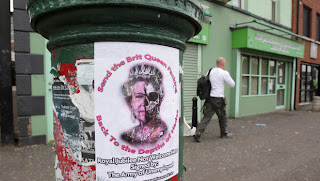The two put differences aside yesterday, however, as they met and shook hands. It is reported that McGuinness went so far as to greet the Queen in the Gaelic Irish, and something about the Troubles and the Peace Process was said in passing. The stipulation of the meeting was that it was not considered to be part of the Jubilee festivities, as Sinn Fein does not recognize that the Jubilee should be celebrated in Northern Ireland. The meeting went well, however, it was completely closed off from the public for security reasons on all sides. A mile perimeter was maintained from the public around the venue of the historic meeting, as extremist loyalists and republicans were both upset at the step forward.
There was no getting around the police barricades around the
meeting with Mr. McGuinness
The venue of the historic meeting- Lyric Theatre
Many were excited for their Queen's visit:
Houses were decked out to the tune of "Rule Britannia"
throughout the Loyalist areas of the city
Cheering Crowds welcomed their Queen in the streets
of Belfast, despite her inability to appear publicly, due to
security concerns
Others were very angry about the Queen coming to Belfast:
Graffiti along the walls of the Falls Road District- the Irish Catholic
neighborhood segregated by the Peace Wall
For those who can't see close enough, it reads "Send the Brit
Queen Packing, Back to the Depths of Hades- You're Not Welcome
Here." These banners were up all over the Irish Nationalist areas, on
telephone poles and held up by protesters.
Protesters outside City Hall, asking about the lost victims
of the Troubles
Protesters along the main route that the royal entourage would
have had to travel
A very moving image could be seen on the hillside above
Belfast, near the spot where the United Irishmen first met to
discuss the dream of an Irish Republic in the late 1700s.
It reads ÉRIU IS OUR QUEEN. Eiru is the ancient personification of Mother Ireland, and beside the giant coloured Irish flag, it was meant to be a symbol to be seen from anywhere in the city as well as from the air.
Regardless where your religion or politics lie, whether Irish Nationalist or Ulster Unionist, Catholic or Protestant, the day marked a historical event in the move forward for Northern Ireland, as the leader of the Sinn Fein party and the Queen of Great Britain were able to meet and be cordial to one another. There is hope that the situation will maintain its stability to a point where a lasting peace is possible. Still a long way to go, but there is hope.












No comments:
Post a Comment